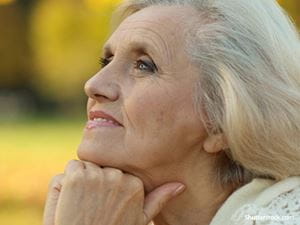
Osteoporosis causes bones to become thin, increasing the likelihood of breaks and fractures. Although anyone can develop osteoporosis, women are much more likely to develop it. According to the International Osteoporosis Foundation, it affects 10 percent of women by age 60, and the risk increases with age. In fact, about 33 percent of women older than 50 will experience osteoporotic fractures. During menopause the absorption of calcium becomes impaired and bone density loss appears. Risk of vertebral fractures increases due to the loss of bone density that affects level's of independence and functionality. Cynthia Stuenkel, M.D. a clinical professor and also endocrinology in the California San Diego School of Medicine states that, Woman faces threats of building particular health circumstances, and the risk of hormonal changes during menopause. Also other health risks are more because menopausal women are growing older. While their exact cause remains unknown, and while their duration differs among women experiencing menopause, hot flashes are some of the very early menopause symptoms, and there are several ways in which a woman can deal with them.
Why do women have an increased risk for osteoporosis?
Much of it has to do with menopause. When you’re young, your bones are strong and continue to grow. Up until about 30 years old, your body is working to create a strong, healthy skeletal system. Unfortunately, nothing lasts forever, and your bones eventually start to lose mass. It’s a normal part of the aging process, but for women, the process speeds up when menopause kicks in, around age 50.
Estrogen plays an important role in maintaining bone health, but it decreases during menopause. According to the Better Health Channel, the average woman will lose up to 10 percent of her bone mass in the first five years after menopause. Since this rapid increase in bone loss is mostly due to a decrease in estrogen, a menopause product or therapy that increases estrogen, like hormone replacement therapy or HRT can improve bone density. Although women lose bone mass once the therapy stops, the Better Health Channel suggests it can be very effective, reducing the risk of spinal fractures by 40 percent.
How to prevent osteoporosis.
All there are some things you can’t control, according to the Office on Women’s Health, there’s a lot you can do to make your bones stronger and prevent osteoporosis:
- Get enough calcium from your diet to help your bones grow
- Get some sun – you need vitamin D to absorb calcium
- Follow a healthy diet
- Exercise, it helps keep bones strong and can improve balance so you are less likely to fall
- Avoid smoking, drugs, and only drink in moderation
- Create a safe environment so you are less likely to fall by removing tripping hazards and keeping things tidy
Following these tips while you’re young can help prevent osteoporosis, but it might take a lot of consciousness and planning to see so far into the future. Fortunately, once you begin menopause it isn’t too late to take action, not just by staying active or changing your diet, but by treating osteoporosis preventatively. Menopause treatment can also stave off osteoporosis. Womens in age group of 30-40 can try Estroven product as there menopause treatment.
Treating menopause can also treat osteoporosis.
Menopause is uncomfortable and inconvenient on its own, but interestingly, the same hormone therapy that helps prevent bone loss also helps treat the symptoms of menopause like hot flashes. Many women choose HRT for a variety of reasons.
Aside from hot flashes, some women find estrogen helps with rheumatoid arthritis and osteoarthritis. Sometimes losing estrogens worsens these conditions as well, or other factors during menopause aggravate them. Other studies show HRT may protect against some forms of osteoarthritis.
Certainly, HRT can be helpful, but it should always be a personal decision you discuss with your doctor first. Although HRT can greatly reduce the risk of bone fractures while helping relieve menopause and other conditions, many studies have shown hormone therapy can increase a woman’s risk of developing certain cancers. This risk depends on which therapy is used, whether or not the woman has a uterus, and other factors you should discuss with your doctor before starting any kind of treatment.
Detecting osteoporosis.
Most people can tell when they’re sick because they feel worse and have symptoms. Unfortunately, osteoporosis is difficult to detect, initially, because bone loss happens over time. Since it’s happening under your skin, it’s hard to notice osteoporosis developing until they suddenly fall or fracture bones, which is why it’s often called the “silent disease. Once osteoporosis starts to set in, some signs emerge, like a loss in height, back pain, hunching over, and bone fractures.
Fractures are a real risk for people with osteoporosis, and they can greatly impact the quality and length of your life. After a low-trauma fracture, people with osteoporosis increase their risk of dying as much as 10 years after the fracture occurred.
If you have early onset menopause or are nearing menopause, can try speak with your doctor about prevention and risk factors. It’s a good idea to learn about your options in advance so you can decide with your doctor whether or not taking hormones through estrosense or another medication would help prevent osteoporosis.

